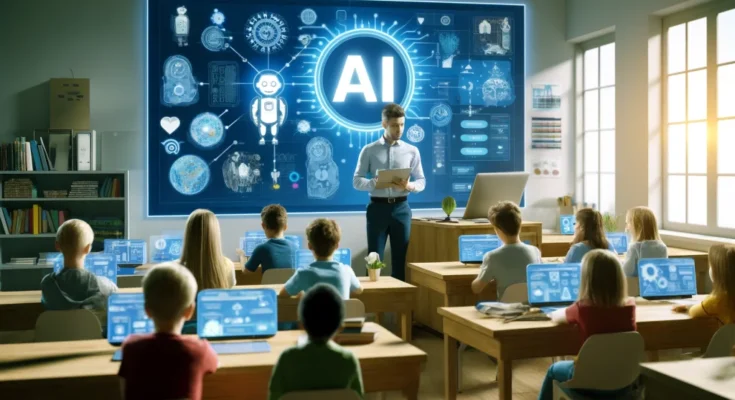Education is rapidly evolving, and at the heart of this transformation lies a powerful force: Artificial Intelligence (AI). From personalized learning to real-time feedback, AI-powered learning platforms for K-12 students are revolutionizing how children learn in the 21st century.
No longer just a tool for tech companies or data scientists, AI in education is now helping teachers deliver customized lessons, parents stay informed, and students receive support tailored to their individual needs. Whether it’s through virtual tutoring, adaptive learning software, or automated assessments, AI is making K-12 learning more engaging, effective, and inclusive.
In this comprehensive guide, we’ll explore how AI learning tools for K-12 work, their benefits and challenges, and which platforms are leading the way. Whether you’re a parent, teacher, or school administrator, this guide will help you understand how to leverage the power of AI to enhance student outcomes.
What Are AI-Powered Learning Platforms?
AI-powered learning platforms are educational technologies that use machine learning, data analytics, and automation to deliver personalized learning experiences. These platforms adapt to a student’s performance, learning style, and pace to ensure they grasp concepts effectively.
Some key features of AI in K-12 education include:
- Adaptive learning paths
- Real-time performance tracking
- Predictive analytics
- AI tutors and chatbots
- Automated grading and feedback
By using these features, AI learning platforms can close learning gaps, boost confidence, and support both advanced and struggling learners.
Why AI Is Transforming K-12 Education
The integration of AI into the K-12 classroom isn’t just a trend—it’s a necessary shift in how we educate. Here’s why AI tools for K-12 students are making such a big impact:
1. Personalized Learning
One of the most searched and desired features in modern education is personalized learning. AI makes this possible by analyzing each student’s performance and customizing content to match their strengths and weaknesses.
2. Improved Engagement
AI platforms often use gamification, interactive lessons, and real-time feedback to keep students engaged. Boring, one-size-fits-all lectures are being replaced by dynamic, student-centered instruction.
3. Data-Driven Decisions
Teachers and school leaders can now use AI-driven analytics to identify struggling students early and modify their teaching strategies accordingly.
4. Anytime, Anywhere Access
AI tools can be accessed remotely, making online learning for K-12 more effective. Students can study at their own pace, review difficult concepts, and access support even outside the classroom.
5. Support for Teachers
AI doesn’t replace teachers—it empowers them. By automating repetitive tasks like grading and attendance, AI gives teachers more time to focus on high-impact teaching activities.
Best AI Learning Platforms for K-12 Students
Let’s explore the top AI-powered educational platforms that are leading the change in K-12 digital learning:
1. Squirrel AI
Squirrel AI Learning is one of China’s most advanced platforms. It provides adaptive learning based on real-time feedback and can pinpoint student weaknesses with high accuracy.
2. Carnegie Learning
This U.S.-based platform offers AI-driven math tutoring. It uses machine learning to adapt lessons to student responses and helps teachers personalize instruction.
3. DreamBox Learning
DreamBox focuses on K-8 math and is highly regarded for its adaptive AI engine. The platform adjusts in real-time and encourages conceptual understanding rather than rote memorization.
4. Century Tech
Used widely in the UK, Century Tech combines AI with neuroscience to create personalized learning journeys. It supports multiple subjects and provides real-time teacher insights.
5. Knewton Alta
While often used in higher education, Knewton Alta’s AI capabilities are now making their way into high schools. The platform tailors lessons and quizzes based on learner behavior.
6. Querium
Querium uses AI to coach students in STEM subjects, especially algebra and physics. Its step-by-step guidance mimics a one-on-one tutor.
7. KidSense.ai
Tailored specifically for early learners, KidSense.ai focuses on voice recognition AI for kids, making digital learning more interactive for K-3 students.
Benefits of AI in K-12 Classrooms
Now let’s take a deeper look at how AI helps different stakeholders in K-12 education.
For Students
- Customized Learning Paths: AI platforms adjust to each student’s pace and preferred learning style.
- Instant Feedback: Real-time responses help students learn from their mistakes immediately.
- Increased Motivation: Gamification and achievement badges boost engagement and morale.
For Teachers
- Automated Grading: Teachers spend less time marking and more time mentoring.
- Classroom Insights: AI highlights trends in performance and attendance.
- Lesson Recommendations: Based on data, AI suggests resources to support struggling students.
For Parents
- Progress Reports: AI platforms generate detailed performance reports.
- Parental Dashboards: Allow parents to track learning time and outcomes.
- Personalized Communication: Automated alerts inform parents when their child needs extra support.
AI and Equity in K-12 Education
One of the most powerful promises of AI in K-12 schools is its potential to make learning more equitable. Here’s how:
- Accessibility: AI tools can support students with disabilities through text-to-speech, closed captions, and screen readers.
- Language Support: AI translators help non-native English speakers learn alongside their peers.
- Individualized Support: Students who fall behind are immediately identified and given targeted interventions.
With the right implementation, AI learning platforms can reduce the achievement gap across demographics and geographies.
Challenges and Ethical Concerns
Of course, no technology is perfect. Here are some of the biggest concerns surrounding AI in K-12 education:
1. Data Privacy
AI platforms collect massive amounts of student data. Schools must ensure data protection policies are in place.
2. Over-Reliance on Technology
There’s a risk of students becoming too dependent on AI tools and losing the ability to think critically.
3. Equity of Access
Not all students have access to devices or reliable internet at home. Schools must ensure that technology doesn’t widen the digital divide.
4. Teacher Training
Educators need professional development to use AI tools effectively.
The Future of AI in K-12 Learning
As AI continues to evolve, expect even more intelligent learning environments:
- Emotional AI that senses student frustration or boredom
- AI mentors that offer career advice and study tips
- AI-powered group learning, where students collaborate in virtual classrooms
The future classroom will blend human creativity with machine intelligence, creating a more personalized, efficient, and inclusive educational experience.
Real-World Success Stories
Here are a few real-world examples of schools successfully using AI learning platforms:
Case Study 1: Florida Virtual School
FLVS integrated AI to help personalize math and reading programs. As a result, student performance increased by 15% within a year.
Case Study 2: India’s BYJU’S Learning App
BYJU’S, powered by AI, customizes content for millions of K-12 learners. It has seen explosive growth and improved test scores among students in rural and urban areas.
Case Study 3: UK Government and Century Tech
Century Tech partnered with the UK Department of Education to deliver personalized learning during the COVID-19 pandemic, ensuring continuity of education for thousands of students.
Frequently Asked Questions (FAQs)
Q1: What are AI-powered learning platforms?
A: They are digital tools that use AI to deliver personalized, interactive, and adaptive learning experiences to students.
Q2: Are AI tools safe for kids?
A: Yes, when managed properly. Always choose platforms with strong privacy policies and transparent data practices.
Q3: Can AI replace teachers?
A: No. AI supports and enhances teaching but cannot replace the human connection, empathy, and creativity that teachers bring.
Q4: How much do AI learning platforms cost?
A: Costs vary. Some platforms offer free versions, while others charge subscription fees. Many schools use bulk licenses or government funding.
Q5: Is AI only useful for high school students?
A: Not at all. AI tools are available for all grades—from kindergarten to 12th grade—and are tailored to age-appropriate content and learning styles.
Final Thoughts: The Future Is Here
AI-powered learning platforms for K-12 are not just futuristic dreams—they’re transforming classrooms today. These tools help students learn better, teachers teach smarter, and parents stay informed. From adaptive assessments to real-time feedback, AI is solving some of the most pressing challenges in education.
As technology continues to advance, schools and educators must embrace these tools while ensuring equity, privacy, and human connection remain at the heart of learning.
Whether you’re a school leader, parent, or student, the time to explore AI in K-12 education is now.




